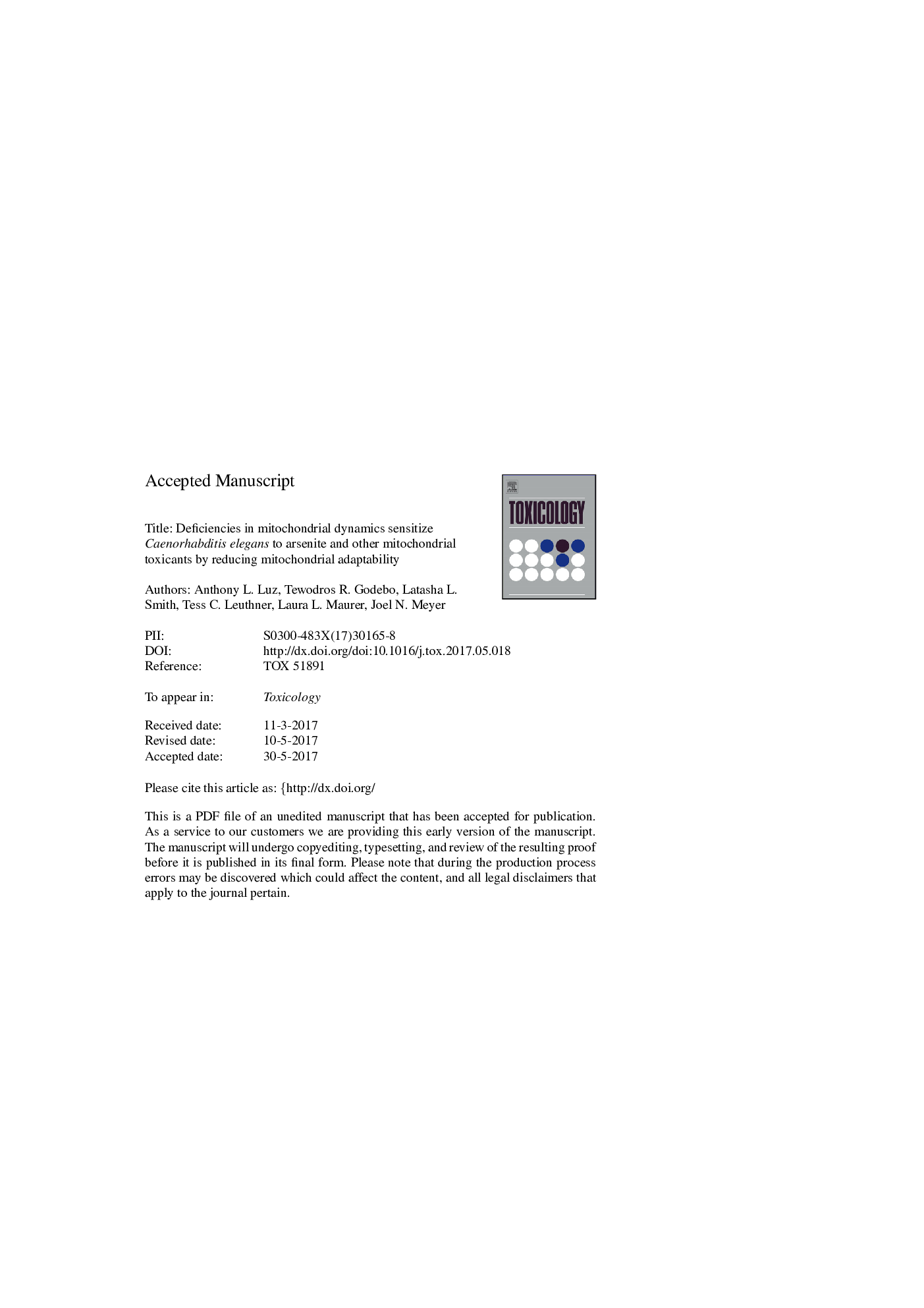| کد مقاله | کد نشریه | سال انتشار | مقاله انگلیسی | نسخه تمام متن |
|---|---|---|---|---|
| 5561746 | 1562285 | 2017 | 45 صفحه PDF | دانلود رایگان |
عنوان انگلیسی مقاله ISI
Deficiencies in mitochondrial dynamics sensitize Caenorhabditis elegans to arsenite and other mitochondrial toxicants by reducing mitochondrial adaptability
دانلود مقاله + سفارش ترجمه
دانلود مقاله ISI انگلیسی
رایگان برای ایرانیان
کلمات کلیدی
DCA3-MAUPRDNPPARK2PINK12-deoxy-d-glucoseDrp1HspMfn1TOFSRCIDHOXPHOSOCRPDHMFN2OMMCMT2A2-DG - 2 DG2,4-Dinitrophenol - 2،4-دینیتروفنل3-methyladenine - 3-متیل آدنینAFB1 - AFB 1Mitochondrial DNA - DNA میتوکندریاNuclear DNA - DNA هسته ایPTEN-induced putative kinase 1 - PTEN-induced kinase assay 1ROS - ROSDominant optic atrophy - آتروفی غالب اپتیکیarsenite - آرسنیتAflatoxin B1 - آفلاتوکسین B1Isocitrate dehydrogenase - ایزوسیترات دهیدروژنازParkinson’s disease - بیماری پارکینسونgene-environment interaction - تعامل ژن و محیط زیستMitochondrial fission - تقسیم میتوکندریDOA - دعاDichloroacetate - دی کلرواساتاتmtDNA - دیانای میتوکندریاییtime of flight - زمان پروازMitochondrial toxicity - سمیت میتوکندریCitrate synthase - سیترات سیتواستاتspare respiratory capacity - ظرفیت تنفس مجزاouter mitochondrial membrane - غشای بیرونی میتوکندریOxidative phosphorylation - فسفوریلاسیون اکسیداتیوMitophagy - میتوفاژیmitofusin 1 - میتوفوزین 1mitofusin 2 - میتوفوسین 2Oxygen consumption rate - میزان مصرف اکسیژنMitochondrial fusion - همجوشی میتوکندریParkin - پارکینUnfolded protein response - پاسخ پروتئین آشکارdynamin-related protein-1 - پروتئین مرتبط با دینامین-1heat-shock protein - پروتئین گرمایی شوکpyruvate dehydrogenase - پیرووات دهیدروژنازReactive oxygen species - گونههای فعال اکسیژن
موضوعات مرتبط
علوم زیستی و بیوفناوری
علوم محیط زیست
بهداشت، سم شناسی و جهش زایی
پیش نمایش صفحه اول مقاله

چکیده انگلیسی
Mitochondrial fission, fusion, and mitophagy are interlinked processes that regulate mitochondrial shape, number, and size, as well as metabolic activity and stress response. The fundamental importance of these processes is evident in the fact that mutations in fission (DRP1), fusion (MFN2, OPA1), and mitophagy (PINK1, PARK2) genes can cause human disease (collectively >1/10,000). Interestingly, however, the age of onset and severity of clinical manifestations varies greatly between patients with these diseases (even those harboring identical mutations), suggesting a role for environmental factors in the development and progression of certain mitochondrial diseases. Using the model organism Caenorhabditis elegans, we screened ten mitochondrial toxicants (2, 4-dinitrophenol, acetaldehyde, acrolein, aflatoxin B1, arsenite, cadmium, cisplatin, doxycycline, paraquat, rotenone) for increased or decreased toxicity in fusion (fzo-1, eat-3)-, fission (drp-1)-, and mitophagy (pdr-1, pink-1)-deficient nematodes using a larval growth assay. In general, fusion-deficient nematodes were the most sensitive to toxicants, including aflatoxin B1, arsenite, cisplatin, paraquat, and rotenone. Because arsenite was particularly potent in fission- and fusion-deficient nematodes, and hundreds of millions of people are chronically exposed to arsenic, we investigated the effects of these genetic deficiencies on arsenic toxicity in more depth. We found that deficiencies in fission and fusion sensitized nematodes to arsenite-induced lethality throughout aging. Furthermore, low-dose arsenite, which acted in a “mitohormetic” fashion by increasing mitochondrial function (in particular, basal and maximal oxygen consumption) in wild-type nematodes by a wide range of measures, exacerbated mitochondrial dysfunction in fusion-deficient nematodes. Analysis of multiple mechanistic changes suggested that disruption of pyruvate metabolism and Krebs cycle activity underlie the observed arsenite-induced mitochondrial deficits, and these disruptions are exacerbated in the absence of mitochondrial fusion. This research demonstrates the importance of mitochondrial dynamics in limiting arsenite toxicity by permitting mitochondrial adaptability. It also suggests that individuals suffering from deficiencies in mitodynamic processes may be more susceptible to the mitochondrial toxicity of arsenic and other toxicants.
ناشر
Database: Elsevier - ScienceDirect (ساینس دایرکت)
Journal: Toxicology - Volume 387, 15 July 2017, Pages 81-94
Journal: Toxicology - Volume 387, 15 July 2017, Pages 81-94
نویسندگان
Anthony L. Luz, Tewodros R. Godebo, Latasha L. Smith, Tess C. Leuthner, Laura L. Maurer, Joel N. Meyer,